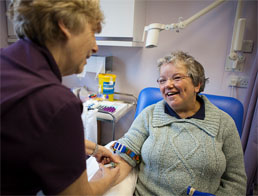
People with learning disabilities have low take-up rates for health promotion or screening activities. Work in the south west of the country to look at reasonable adjustments a couple of years ago resulted in a number of recommendations for local action along with recommendations to the national cancer screening programmes regarding the identification of people with learning disabilities in NHS Cancer Screening databases, to enable reasonable adjustments to be put in place.
The National Development Team for Inclusion (NDTi) in partnership with the Norah Fry Research Centre, were commissioned by Cornwall Partners in Policymaking to develop an evidence based toolkit and strategy for improving access to screening services (bowel, cervical, breast, abdominal aortic aneurysm and diabetic retinopathy) by people with learning disabilities in the South West as well as offering further recommendations to inform the national debate on identification of people with learning disabilities in national cancer screening programmes.
Method
What the research team did was first to carry out a literature search to identify good practice. They worked with people with learning disabilities and family carers as well as representative organisations like Devon Link Up and HealthWatch Devon. They also carried out a scoping exercise to identify current practice and resources regarding the five national screening programmes.
Issues identified in the literature
The literature review identified a number of issues
- Rates of uptake:
- women with learning disabilities have a much lower participation rate in cervical and breast screening programmes than women in the general population
- people with learning disabilities are significantly less likely to receive cancer screening tests than those without learning disabilities
- significant empirical evidence is lacking about uptake of bowel, AAA and diabetic retinopathy screening by people with learning disabilities some local data from South West shows a lower uptake.
- Barriers to uptake
- lack of routine use of easy read invitations, difficulties using appointment systems and mobility issues.
- communication barriers
- attitude and knowledge of professionals
- people with learning disabilities may not understand the importance of screening
- fear and anxiety can be a barrier to participation.
- concerns about the capacity of people with learning disabilities to consent
- staff unaware of accessible/easy read materials – the team uncovered a good range of easy read materials which were readily accessible.

Barriers to uptake include lack of use of easy read invitations,
communication barriers and attitude and knowledge of professionals
- Evidence on improved uptake
- lack of robust evaluation of interventions to improve uptake however, some evidence to support:
- education, training and support for professionals, support staff and family carers and for people with learning disabilities – careful preparation can increase the likelihood of a successful screening test.
- partnership working between Community Learning Disability Team nurses and primary care staff could increase uptake of cervical screening
- lack of robust evaluation of interventions to improve uptake however, some evidence to support:
The team also identified some overarching issues
- The Mental Capacity Act
- all concerned with supporting somebody around a screening decision need to consider firstly, capacity to consent. If a person is considered not to have capacity to consent then there must be use of the best interests process. This may be particularly relevant if the screening test is difficult or invasive.
- Information governance
- the team found occasions where information had been withheld because of anxiety about protecting confidentiality, but point out that managing information sharing well is important if someone lacks capacity to make decisions for themselves.
The team recommend that
pathways for people with learning disabilities should include explicit consideration of information sharing to ensure that all those involved in supporting a person with learning disabilities have the information they will need to support effective participation in screening and any follow-up action.”
Recommendations for the National Programme
The research team identify local good practice examples and use these to inform a number of actions to be taken locally for each of the five screening programmes.
In addition, they also identify recommendations for the national programmes. As an overarching recommendation they suggest that
- Issues relating to access to screening, in particular better identification in national databases should be addressed within the national programmes.
For each of the five national programmes they recommend:
Cervical Screening
- The need for a national cervical screening pathway for women with learning disabilities, including identification and the provision of reasonable adjustments.
- Clarification of the QOF (Quality and Outcomes Framework – an annual reward and incentive programme detailing GP practice achievement results) rules in relation to women who lack capacity to consent or dissent.
Breast screening
- Continuation of approach whereby women are kept on the system for as long as they remain eligible so that if it is not possible to screen at the first attempt, further attempts can be made
- Recording on the system of learning disability as a variable and recording of reasonable adjustments should be used for regular audit of performance.
Bowel screening
- There should be a national bowel screening pathway for people with learning disabilities including identification and the provision of reasonable adjustments.
- As there is currently no practical way of identifying people with learning disabilities in the national bowel screening programme easy read information should be sent out as the default option.
- Given that GPs are notified of non responders, it is possible to identify people with learning disabilities who have not responded, giving the opportunity for GP practices to work with local learning disability teams to seek additional support for the person to enable participation.
- A positive result triggers a fast track response (14 day turnaround) so the bowel screening kit should include information that enables the person returning it to let the screening centre know they have a learning disability
- Local learning disability services should send the screening hubs a link to the acute liaison nurse map on the Improving Health and Lives website (when it becomes available), for onward referral when people have had a positive screen.
Diabetic retinopathy screening
- There should be a national diabetic retinopathy screening pathway for people with learning disabilities including identification and the provision of reasonable adjustments. This could include national easy read resources.
- The current information system should include a field allowing extra needs, e.g. relating to a learning disability, to be recorded in order that reasonable adjustments can be made.
Abdominal aortic aneurysm (AAA) screening
- There should be a national AAA screening pathway for people with learning disabilities including identification and the provision of reasonable adjustments.
- A standardised easy read invitation letter should accompany the existing easy read information leaflet.
- The need to clarify how men without capacity can be supported to participate in AAA screening with reference to the Mental Capacity Act.
- Work with NHS England to ensure that AAA screening is included in the specification for the Annual Health Check for people with learning disabilities
Conclusion and comment

An excellent resource using local best practice to inform national recommendations
This is an excellent resource that draws on local good practice and engagement with local stakeholders to identify how things could be done well and uses this to offer up recommendations for local improvements and recommendations for national changes.
In addition to the recommendations, each of the screening programmes is explained in detail, so it is an excellent resource for anybody wanting to have information to help explain the processes involved to people they support.
In the appendices, there are pathways for each of the screening programmes with links to examples and sources of easy read information which are clearly laid out.
The Improving Health and Lives team have previously reported on the lack of reasonable adjustments in the provision of screening services, and this piece of work goes a long way towards clarifying what needs to be done to improve this situation.
Link
Improving the uptake of screening services by people with learning disabilities across the South West Peninsula, A Strategy and Toolkit. National Development Team for Inclusion and Norah Fry Research Centre

Improving cancer screening for people with learning disabilities via @LearningDisElf http://t.co/0bzqxbPry0 http://t.co/O5V1WGSK9t
RT @LearningDisElf: Practical recommendations to improve uptake in cancer screening services by people with learning disabilities http://t.…
Sara-Marie Evans liked this on Facebook.
Cheryl Hillis liked this on Facebook.
Jen Shrek liked this on Facebook.
Sheila Harrold liked this on Facebook.